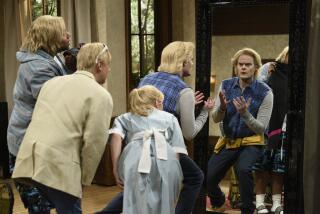The blueprint in newsprint
- Share via
By the mid-1950s, Charles Schulz was hitting his stride as a cartoonist, and “Peanuts” was evolving rapidly. It began modestly in 1950 as an expanded version of “Li’l Folks,” the strip he drew for the St. Paul Pioneer. “Li’l Folks” consisted of spot cartoons about small children with improbably sophisticated vocabularies -- a popular theme in ‘40s magazine cartoons. By 1955, the precocious kids had become real characters with distinct personalities.
In this third volume of a set that will encompass the 50-year run of the strip, Linus stops crawling and starts walking. He’s not yet the intellectual/theologian he will become, but he’s no longer a baby in sleepers. Lucy has attained the rank of “World’s Number One Fussbudget” by studying books like “The Power of Positive Fussing,” and “I Was a Fussbudget for the F.B.I.” In December 1956, she snatches the football when Charlie Brown runs to kick it, starting one of the strip’s longest-running gags.
Snoopy is already walking on his hind legs and beginning to live in the fantasy world that will expand to encompass the WW I Flying Ace and NASA astronaut. He does his first “happy dance” in September 1956, and he upsets Charlie Brown with his impressions of animals, the kids in the strip and Beethoven. Schulz’s work wouldn’t reach its apex for several more years, but “Peanuts” was already an important strip in 1955, when the artist won his first Reuben Award.
Schulz was also learning what his strip didn’t need. He began phasing out comic foils Shermy, Violet and Patty. The carefully drawn rooms of mid-century furniture were being replaced by simple exteriors. Schulz’s characters grew so vivid they didn’t require elaborate settings: an empty landscape with tufts of grass, an occasional tree and a stone wall to lean on sufficed.
While most comic strip artists used extreme expressions and emotions -- Sergeant Snorkel screaming at Beetle Bailey or Dagwood yelling for Blondie when something went wrong -- Schulz underplayed. In a few spare lines, he suggested ennui, loneliness, bewilderment and resignation. But Schulz’s minimalism is deceptive in its simplicity: Those carefully chosen lines have to be perfect or they don’t work at all. If Snoopy didn’t hold his head at exactly the right angle when he was happy or Linus’ eyebrows came down a little too far when he scowled, the drawing wouldn’t read properly and the joke would fall flat. Schulz summed up the draftsmanship underlying his strip when he said, “To draw a good cartoon hand, you have to be able to draw a good hand.”
In his lively introduction, Matt Groening recalls when he and his friends discovered how difficult it was to copy their favorite comic strip characters: “We especially loved copying the ‘Peanuts’ kids, because they seemed simple enough at first glance. But it turned out those giant heads and dots for eyes were trickier than they looked.... In our wobbly hands, Charlie Brown’s big round head turned into a macrocephalic oval, his eye dots drifted apart, and his body got fatter and more squished. No matter how much we practiced, our Charlie Browns looked like freaks.”
The understated clarity of “Peanuts” influenced virtually every comic strip that’s appeared in recent decades. “Calvin and Hobbes” creator Bill Watterson said, “One can scarcely overstate the importance of ‘Peanuts’ to the comics, or overstate its influence on all of us who have followed.”
The best new artists apply what they learned from Schulz to their own strips, as “Thrashed,” the ninth collection of “Zits” by Jerry Scott and Jim Borgman, demonstrates. “Zits” debuted in 1997 and now appears in 1,100 newspapers. It’s easy to understand why it has become so popular so quickly: Scott and Borgman marry words and images to create characters who are lively, dimensional -- and often hilarious.
The high school kids in “Zits” reflect the worries, fears, joys and trends of contemporary life, just as the “Peanuts” characters reflected their world. Charlie Brown, Schroeder and Linus wore Davy Crockett coonskin caps, played marbles and watched black-and-white TV; Jeremy, Pierce, Hector and Sarah are never without backpacks, cellphones and CD players. Borgman’s crisp drawings allow the artists to use purely visual gags that wouldn’t work in sloppier strips. When aspiring rock star Jeremy tries to develop a “Bob Dylan sneer,” the drawings are funny not because they depict silly expressions but because they capture the postures of a teenager imitating a model he really doesn’t understand. Jeremy feels alive, just as Charlie Brown and Snoopy do.
Volume three of “The Complete Peanuts” reveals how one of the masters of the comic strip developed; “Thrashed” shows that talented individuals are still drawing inspiration from Schulz’s landmark creation and continuing the art form he loved. *
More to Read
Sign up for our Book Club newsletter
Get the latest news, events and more from the Los Angeles Times Book Club, and help us get L.A. reading and talking.
You may occasionally receive promotional content from the Los Angeles Times.










